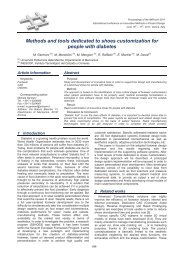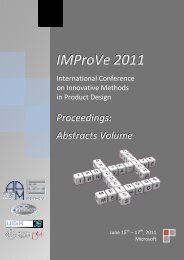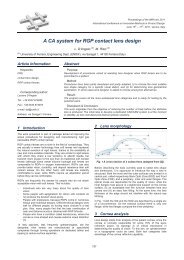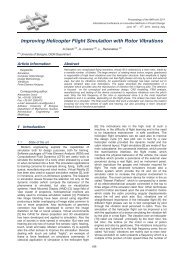IMProVe 2011 - Proceedings
IMProVe 2011 - Proceedings
IMProVe 2011 - Proceedings
You also want an ePaper? Increase the reach of your titles
YUMPU automatically turns print PDFs into web optimized ePapers that Google loves.
Innovative Methods in Architectural Design<br />
Design time and time architecture<br />
P. J. Juan Gutiérrez (a)<br />
(a) Universidad de Alicante<br />
Abstract:<br />
Undoubtedly the way in which we inhabit a building is different from the way we use an<br />
object, especially as far as timing is concerned. Although we are part of the architecture<br />
the same way that objects are our most immediate and artificial extension, they are<br />
(usually smaller than that of an architectural construction) those who construct<br />
discontinuously our intratemporality.<br />
This communication, through the proposed analysis, demonstrates the importance of<br />
knowing (and therefore understand) the time scale that defines and enables our objects.<br />
Only through the tool that is the consciousness of his reality we will be able to get to<br />
optimize our designs in order that our intentions are expressed through our objects.<br />
Keywords: Time, Design, Architecture, SANAA<br />
Corresponding Author: Pablo Jeremías Juan Gutiérrez<br />
e-mail: pablo.juan@ua.es<br />
New materiality: digital fabrication and open form<br />
Notes on the Arbitrariness of Architectural Form<br />
and Parametric Design.<br />
C. L. Marcos (a)<br />
(a) Departamento de Expresión Gráfica y Cartografía. Escuela Politécnica Superior.<br />
Universidad de Alicante<br />
Abstract:<br />
Digitally conscious architectural design is founded on the assumption that computer tools<br />
should modify architecture’s own language, not just the way architects must work.<br />
The idea of open form is the result of producing encoded designs, that is: geometry is<br />
defined parametrically and codified in a non material language instead of being imposed<br />
over materiality –drawings or physical models- as is characteristic to architectural design<br />
tradition. A parametric design is open in as much as it defines a topological model where<br />
the connectivity between the parts and their relation to the whole generates a typology of<br />
possible designs limited by the range of parameters involved. Some parallels can be drawn<br />
with Eco’s idea of open form referring to some artistic production of the second half of the<br />
XX century.<br />
The increased complexity that can be achieved with new design tools has often led to a<br />
banal formalism inconsistent with architecture’s own tradition. The baroqueness of recent<br />
167<br />
June 15 th – 17 th , <strong>2011</strong>, Venice, Italy<br />
<strong>IMProVe</strong> <strong>2011</strong> - <strong>Proceedings</strong>










